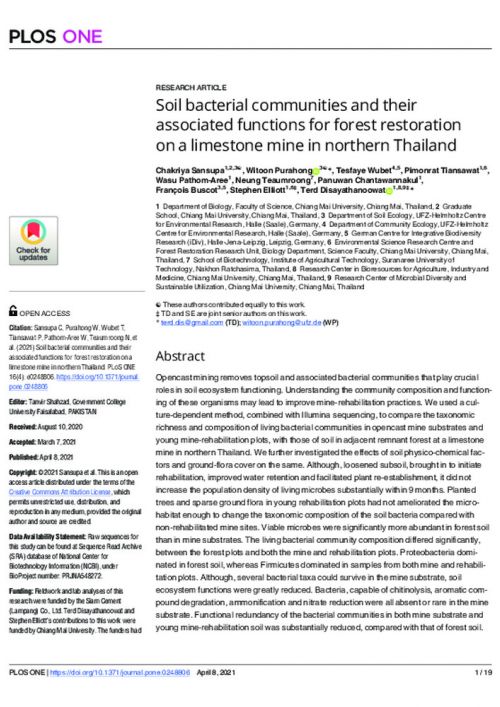Soil bacterial communities and their associated functions for forest restoration on a limestone mine in northern Thailand

ABSTRACT: Opencast mining removes topsoil and associated bacterial communities that play crucial roles in soil ecosystem functioning. Understanding the community composition and functioning of these organisms may lead to improve mine-rehabilitation practices. We used a culture-dependent method, combined with Illumina sequencing, to compare the taxonomic richness and composition of living bacterial communities in opencast mine substrates and young mine-rehabilitation plots, with those of soil in adjacent remnant forest at a limestone mine in northern Thailand. We further investigated the effects of soil physico-chemical factors and ground-flora cover on the same. Although, loosened subsoil, brought in to initiate rehabilitation, improved water retention and facilitated plant re-establishment, it did not increase the population density of living microbes substantially within 9 months. Planted trees and sparse ground flora in young rehabilitation plots had not ameliorated the micro-habitat enough to change the taxonomic composition of the soil bacteria compared with non-rehabilitated mine sites. Viable microbes were significantly more abundant in forest soil than in mine substrates. The living bacterial community composition differed significantly, between the forest plots and both the mine and rehabilitation plots. Proteobacteria dominated in forest soil, whereas Firmicutes dominated in samples from both mine and rehabilitation plots. Although, several bacterial taxa could survive in the mine substrate, soil ecosystem functions were greatly reduced. Bacteria, capable of chitinolysis, aromatic compound degradation, ammonification and nitrate reduction were all absent or rare in the mine substrate. Functional redundancy of the bacterial communities in both mine substrate and young mine-rehabilitation soil was substantially reduced, compared with that of forest soil. Promoting the recovery of microbial biomass and functional diversity, early during mine rehabilitation, is recommended, to accelerate soil ecosystem restoration and support vegetation recovery. Moreover, if inoculation is included in mine rehabilitation programs, the genera: Bacillus, Streptomyces and Arthrobacter are likely to be of particular interest, since these genera can be cultivated easily and this study showed that they can survive under the extreme conditions that prevail on opencast mines.
Related Advice
Biodiversity
Biodiversity recovery is one of the main aims of forest restoration - but what to measure? Plants? Birds? Mammal? Learn simple monitoring techniques here.



